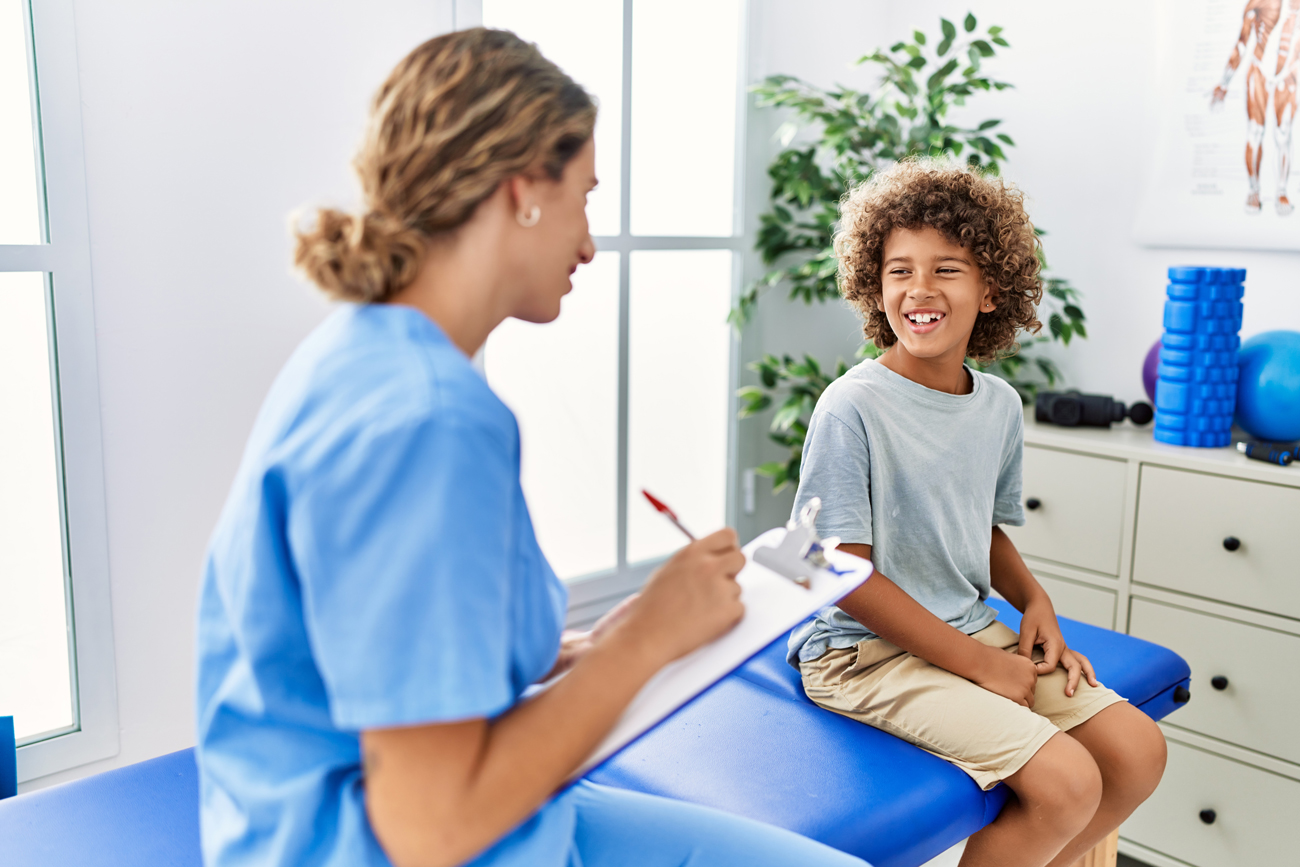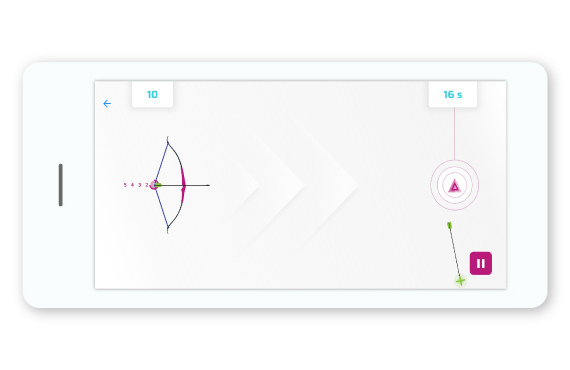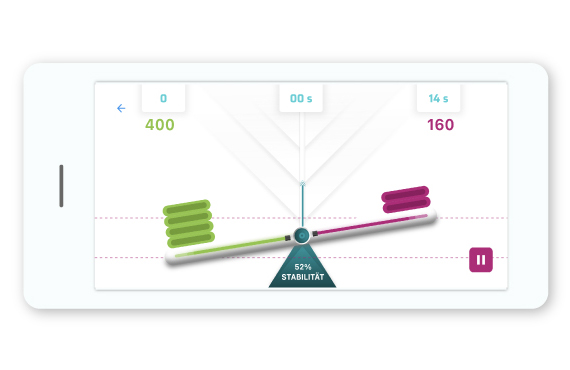Pelvic floor training for children and teenagers
Help your child learn to identify and relax the pelvic floor with the PelvicTool Home & Sport.
Why pelvic floor therapy for children?
The pelvic floor is an important muscle group in the body that is often underestimated – especially in children. However, well-functioning pelvic floor muscles are an essential key to the health of boys and girls, not only for urinary incontinence and nocturnal enuresis, but also as they reach puberty and adulthood. Biofeedback pelvic floor training can improve quality of life in the long term.

Where are the pelvic floor muscles located?
The pelvic floor forms the lower end of the abdomen; its muscles are directly attached to the bony pelvis. Together with the back muscles, it is important for posture, supporting the abdominal organs, helping to balance pressure when we cough or sneeze, and controlling the emptying of the bowel and bladder.
Why is the pelvic floor so important, especially for children?
Peeing has to be learned It’s not as trivial as it sounds, because urination is a complicated interaction between the bladder muscles and the external bladder sphincter. A well-functioning pelvic floor is also essential for faecal continence, as well as for upright posture, breathing and, in older age, sexuality. With progressive development and a little practice, the child can usually acquire the ability to control the bladder voluntarily, first during the day and later at night. There are large individual differences in the time at which continence is achieved.
When should you take your child to the doctor?
Not all children make the important step of going dry at the same rate. As a parent, it is important to be supportive and understanding and to give your child the time they need. If the child is a little older and suffering from enuresis, it is advisable to see a doctor. Parents should be aware that inborn bladder dysfunction can have a variety of causes, including organic, neurological and psychological factors. A medical diagnosis by a paediatric urologist will be followed by a treatment recommendation. Pelvic floor therapy with a physiotherapist is a helpful option in many cases.
Pelvic floor therapy for children
Pelvic floor physiotherapists specialising in children patiently support young patients on their way to dryness. First, the anatomy of the pelvic floor and pelvic organs is explained to the child in an age-appropriate way, then drinking and toilet behaviour are analysed together. This is followed by specific exercises to strengthen and increase awareness of the pelvic floor muscles. The non-invasive PelvicTool Home & Sport has proven itself as a training device – it is easy to use and the playful structure of the training app makes it easy for children to learn to recognise and relax the pelvic floor. The PelvicTool is also used in fecal incontinence therapy to improve coordination and relax the pelvic floor.
Pelvic Floor Training with Biofeedback: PelvicTool
The PelvicTool from Alonea works with biofeedback to teach your child how to tense and relax their pelvic floor in a playful way. The gentle, non-invasive method ensures painless and effective strengthening of the pelvic floor.

Training your pelvic floor in a fun way
The PelvicTool pelvic floor training device works in conjunction with the PelvicTool Home & Sport app. The child selects the appropriate game on the smartphone or tablet together with the therapist to target the problem.


Pelvic floor trainer with app: PelvicTool Home & Sport

.
Helps your child strengthen and control their pelvic floor muscles in a playful way.
How will my child train with the PelvicTool?
Children and adolescents suffering from pelvic dysfunction should receive therapeutic support. Regular exercise at home is important for progress and can easily be done at home under the guidance of a physiotherapist or urotherapist:
- The PelvicTool is placed on a flat surface, such as a stool; it consists of a comfortable seat cushion and a soft sensor tube attached to the centre of the cushion.
- The child can sit on it in light training clothes and use the PelvicTool- app on a smartphone or tablet to complete the playful training programmes. Important: The feet must be flat on the floor or on a stool.
- Thanks to biofeedback, you can see on screen in real time how your pelvic floor muscles tense and relax as you do the exercises. A great way to train awareness, and even fun for the kids!

Healthy pelvic floor for the whole family
- Improved awareness and control of pelvic floor muscles. The PelvicTool uses biofeedback to support your child’s pelvic floor awareness in a playful way.
- Progress monitoring. The visual feedback provided by biofeedback allows children to track their progress and motivates them to do their best. This makes training fun and rewarding – an important part of keeping them engaged and enjoying their training.
- Preventing health problems. A well-coordinated pelvic floor in children can help prevent problems such as bedwetting, faecal incontinence and urinary tract infections. This means that supported pelvic floor therapy lays the foundation for a lifetime of good health.
- High quality materials. Our biofeedback pelvic floor trainer is made from high quality materials that are safe and durable. This makes the PelvicTool suitable for the sensitive skin and needs of children, especially as no direct skin contact is required.
- No special cleaning required – simply wipe with a damp cloth after pelvic floor training.
- Health for the whole family. Mums, dads, siblings and grandparents can all exercise with the PelvicTool. Well coordinated pelvic floor muscles are essential for the health and well-being of the whole family!
Where can I get the PelvicTool?
Kinderklinik Bern, Kinderspital Luzern, Ostschweizer Kinderspital St. Gallen
To find a pelvic floor therapist, you can use the Directory of therapists from pelvisuisse or ask your paediatric urologist for a recommendation. If you are specifically looking for a practice that uses the PelvicTool, please ask about it before starting therapy.
Rent or buy
In addition to selling the PelvicTool, some Alonea sales partners also offer monthly rental of the PelvicTool.
Switzerland: Parsenn Produkte AG, Küblis Phone 081 300 33 33
Germany: Beckenbden-Gesundheit.com, Sulzberg, Tel. +49 157 8864 53 79
Pelvic floor training for children: better awareness of the pelvic floor with biofeedback
The PelvicTool Home & Sport is based on the principle of biofeedback. When training with biofeedback, barely perceptible bodily processes such as the tensing and relaxing of the pelvic floor muscles are measured by sensors and converted into visible signals. The biofeedback technique has proved ideal for pelvic floor training because the pelvic floor muscles are hidden inside the body and many people find it difficult at first to feel the right muscle and to move and control it voluntarily.

Success monitoring via app
The pelvic floor muscles are located inside the body. This makes it difficult to judge whether the right muscles are being used during exercise. Active neuromuscular control is usually limited, especially at the beginning of exercise. The PelvicTool App provides a remedy by allowing visual control of the training.
These articles may be of interest to you:
Urinary incontinence: bladder weakness what to do
What is urinary incontinence? How common is bladder weakness? What are the different forms of urinary incontinence? How can pelvic floor training help with urinary incontinence?
Cost sharing for the purchase of a PelvicTool pelvic floor trainer for CSS supplementary insurance policyholders
The purchase of a PelvicTool will be supported with a corresponding additional insurance from CSS with a cost contribution (Switzeland only).
Health insurance Helsana: 90 % cost reimbursement for «PRIMEO» supplementary insurance policyholders
The PelvicTool Home & Sport pelvic floor trainer is now included in the list of medical products that are supported by Helsana with cost sharing.
Sources, links and further reading
Scientific publications
- Jacobsen LV, Jørgensen CS, Kaas Sørensen KM, Enemark L, Rittig S, Kamperis K. The efficacy of physiotherapeutic intervention with biofeedback assisted pelvic floor muscle training in children with dysfunctional voiding. J Pediatr Urol. 2021 Dec;17(6):793.e1-793.e6. doi: 10.1016/j.jpurol.2021.09.022. Epub 2021 Sep 25. PMID: 34635441 Free article.
- Pfister C, Dacher JN, Gaucher S, Liard-Zmuda A, Grise P, Mitrofanoff P. The usefulness of a minimal urodynamic evaluation and pelvic floor biofeedback in children with chronic voiding dysfunction. BJU Int. 1999 Dec;84(9):1054-7. doi: 10.1046/j.1464-410x.1999.00377.x. PMID: 10571635
- Ladi-Seyedian SS, Sharifi-Rad L, Nabavizadeh B, Kajbafzadeh AM. Traditional Biofeedback vs. Pelvic Floor Physical Therapy-Is One Clearly Superior? Curr Urol Rep. 2019 May 30;20(7):38. doi: 10.1007/s11934-019-0901-9. PMID: 31147796 Review.
- Nieuwhof-Leppink AJ, Hussong J, Chase J, Larsson J, Renson C, Hoebeke P, Yang S, von Gontard A. Definitions, indications and practice of urotherapy in children and adolescents: – A standardization document of the International Children’s Continence Society (ICCS). J Pediatr Urol. 2021 Apr;17(2):172-181. doi: 10.1016/j.jpurol.2020.11.006. Epub 2020 Nov 5. PMID: 33478902 Review.
- Khen-Dunlop N, Van Egroo A, Bouteiller C, Biserte J, Besson R. Biofeedback therapy in the treatment of bladder overactivity, vesico-ureteral reflux and urinary tract infection. J Pediatr Urol. 2006 Oct;2(5):424-9. doi: 10.1016/j.jpurol.2005.09.004. Epub 2005 Oct 25. PMID: 18947650
Clinical trials
- van Gool JD, de Jong TP, Winkler-Seinstra P, Tamminen-Möbius T, Lax H, Hirche H, Nijman RJ, Hjälmås K, Jodal U, Bachmann H, Hoebeke P, Walle JV, Misselwitz J, John U, Bael A; European Bladder Dysfunction Study (EU BMH1-CT94-1006). Multi-center randomized controlled trial of cognitive treatment, placebo, oxybutynin, bladder training, and pelvic floor training in children with functional urinary incontinence. Neurourol Urodyn. 2014 Jun;33(5):482-7. doi: 10.1002/nau.22446. Epub 2013 Jun 15. PMID: 23775924 Clinical Trial.
- Bael A, Lax H, de Jong TP, Hoebeke P, Nijman RJ, Sixt R, Verhulst J, Hirche H, van Gool JD; European Bladder Dysfunction Study (European Union BMH1-CT94-1006). The relevance of urodynamic studies for Urge syndrome and dysfunctional voiding: a multicenter controlled trial in children. J Urol. 2008 Oct;180(4):1486-93; discussion 1494-5. doi: 10.1016/j.juro.2008.06.054. Epub 2008 Aug 16. PMID: 18710726 Clinical Trial.
- Combs AJ, Glassberg AD, Gerdes D, Horowitz M. Biofeedback therapy for children with dysfunctional voiding. 1998 Aug;52(2):312-5. doi: 10.1016/s0090-4295(98)00189-7. PMID: 9697801 Clinical Trial.
- McKenna PH, Herndon CD, Connery S, Ferrer FA. Pelvic floor muscle retraining for pediatric voiding dysfunction using interactive computer games. J Urol. 1999 Sep;162(3 Pt 2):1056-62; discussion 1062-3. doi: 10.1016/S0022-5347(01)68065-0. PMID: 10458431 Clinical Trial.
Stay up to date
Subscribe to our newsletter here and receive valuable tips for pelvic floor training. Free of charge and can be cancelled at any time.




